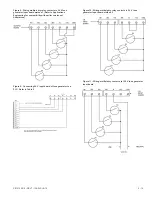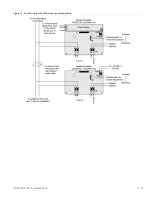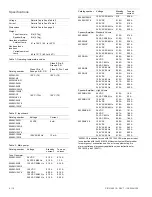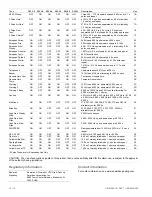
2 / 10
P/N 3100010 • REV 7 • ISS 04AUG10
Installation
The Adaptatone may be mounted to any flat surface or may
be used as a freestanding unit mounted to a rigid pipe. The
Adaptatone must be installed in accordance with the latest
edition of the National Electrical Code or other regulations
applicable to the country and locality of installation and by a
trained and qualified electrician.
NOTE: The increased resistance due to long wire runs
needs to be accounted for in sizing wire. Consult
Applications Engineering for details.
For catalog numbers ending in "AQ", 24 VAC power must be
transformer isolated from mains or line power.
WARNING:
To prevent fire, shock and component damage,
NO work, including circuit board removal, should be
performed while the circuit is energized.
NOTE: Any kind of service or maintenance performed
while unit is energized will void the warranty.
1. Mount Adaptatone as shown in Figure 1.
a.
Flat Surface Mounting
. Secure unit to mounting
surface using the (4) mounting holes in the
mounting plate on the rear of the box. Use the #10
x 3" (76 mm) wood screws (furnished loose) or
other hardware (not supplied) suitable for the
mounting surface.
b.
Rigid Pipe Mounting
. Loosen the (4) cover
screws from the signal box and lift off signal box
cover.
NOTE: Cover screws are captive. Do not remove from
cover.
Remove the center knockout in lower wall of box
and mount box to a 1/2” (12.7 mm) conduit pipe
using suitable connector.
2. Wire in accordance with the instructions in “Wiring.”
3. Refer to Figure 14 and Figure 15 and Table 6 and select
desired tones. Set miniature programming switches on
the input board.
For input connected to IN1, set on SW1; IN2, set on
SW2; IN3, set on SW3, and IN4, set on SW4, in order of
priority desired.
4. Adjust volume level, if desired, by turning potentiometer
located on the main board (Figure 14 - Figure 17) and
on voice board (Figure 16).
WARNING:
HIGH VOLTAGE is present when product is
energized. High volume may cause harm to personnel in
close proximity.
5. To adjust speaker direction, loosen large star nut
(Figure 1) and turn speaker to the approximate desired
position.
WARNING:
To ensure integrity of the Adaptatone assembly
when adjusting the speaker direction, make sure threads in
the enclosure remain fully engaged and do not turn speaker
more than 360 degrees from the original factory installed
position.
Ensure that the (4) collar gaskets, part number P-041930-
0362, are in place on each cover screw before securing the
signal box cover.
When securing cover, start screws by hand, making sure
they are threaded into tapped holes in housing bosses
before securing with a screwdriver. Torque signal box cover
screws to a minimum of 20 in-lbs. This ensures the required
tight fit.
Retighten nut and turn speaker slightly clockwise until
locked into place.
6. Tightly secure the signal box cover using (4) retained
cover screws.
7. Torque signal box cover screws to a minimum of 20 in-
lbs.
8. Verify
operability.
Wiring
1. Install wires through a knockout hole in the bottom of
the box from a raceway that is, with its connections to
the 1/2" conduit knockout hole, approved for the same
degree of protection and enclosure type needed by the
application. Use the provided plastic tie-wrap, on the
barrier to the electronics, to separate incoming power
leads from signal and tone initiating leads, per NEC
(Figure 4 - Figure 6).
WARNING:
To prevent fire and shock, wire the Adaptatone
only as described in this installation instruction.
2. Wire as follows referring to Figure 4 - Figure 6. (These
instructions apply to both tone generator and 5532M
series speaker/amplifier, except as noted):
If Edwards Signal Actuator catalog number 5538-4 is
used to manually initiate tones, connect its four
normally-open switches to the Tone Generator as
shown on instructions provided with the Signal Actuator
unit.
a. Connect green and yellow-striped earth-ground
wires to earth-ground and, additionally, on tone
generator, to braid or drain of audio cable in step b.
b. See Figure 5 and Figure 13 - Figure 16. Connect
audio output (+) from the main board of the tone
generator to the AUD (+) terminal on the Speaker /
Amplifier audio coupler board. Use shielded cable
and connect braid or drain to earth-ground wire
lead of 5540 tone generator. Up to 2500
speaker/amplifiers can be so connected in parallel
to a single tone generator.




























